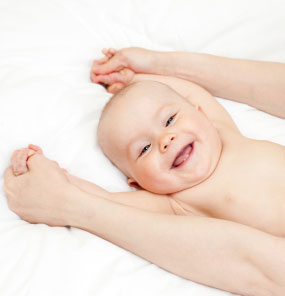
“Have a quick hour,” pregnant women are often wished, alluding to the rigors of labor. A physiological process that begins with a series of increasing contractions until the cervix dilates to 10 centimeters and culminates with the delivery of the fetus and placenta.
The 12-centimeter journey from the womb to the outside world is the most risky journey of life. A journey lasting much longer than an hour. Six, twelve, fifteen hours are common times between dilation and delivery.
Pain, nerves, even fear, are inherent to the adventure of giving birth. But so is excitement, joy, even euphoria. The experience is so intense that at many dinners for forty-somethings, the men end up recounting their mistresses and the women their births. And each one recounts how it went (report in El País Semanal).”
Pediatric Osteopathy: Children and Babies
Craniosacral Therapy
❉
Due to the gentleness of its manipulations and its ability to stimulate the body’s own health resources, Craniosacral Therapy is well-suited for the treatment of children from birth. The newborn’s skull must be examined, and our examination and that of the pediatrician’s are complementary.
Various “mishaps” during birth can make a delivery less than natural and simple: the use of forceps or a vacuum to extract the baby, the umbilical cord wrapped around the baby’s neck, the baby’s presentation in a position other than normal (breech, one-armed, etc.), a cesarean delivery, an epidural that prevents the mother from directing the contractions, psychological problems of the mother, etc. Sometimes these children present asymmetries in the shape of their head and/or in the movement of their arms and legs, who take a long time to suck when eating, who cry excessively, are overly sensitive to any stimulus, regurgitate frequently, vomit, have constipation and gas, have breathing difficulties, strabismus and hearing problems, loss of appetite, gastric problems, torticollis, scoliosis (a deviation of the spine), slow or irregular development, insomnia… Other times, symptoms appear when the child starts school: hyperactivity, attention deficit hyperactivity disorder, learning disabilities, dyslexia…
In general, we can say that the skull experiences compression in any birth, and this is natural. The body’s self-correcting system will correct many tensions, but there will still be a percentage of babies who need craniosacral correction.
At birth, the condylar portion of the occipital bone is not completely ossified; cartilage is still present to allow for a certain flexibility necessary for delivery. During delivery (even in apparently uneventful births), compression can occur—hyperextension of the head with the neck, i.e., of the occipital bone with the upper cervical vertebrae—which would cause the condyles to become trapped on the articular surface of the atlas. If this condylar compression is not self-corrected or treated, it can impair the growth of the occipital bone. Since cartilage is malleable and bones grow in the direction of least resistance, this compression (interference) can easily result in abnormal growth and development of the occipital bone. Some soft tissues may even become fibrotic or hypertonic. Another possible result is increased posterior pressure on the outflow of blood through the jugular foramen (located between the occipital and temporal bones). The jugular veins exit the skull through these foramina, as do the glossopharyngeal, vagus, and spinal accessory cranial nerves. All of these can cause very common problems in babies. Problems can also develop later in life, when the person’s compensatory capacity is exhausted: depression, migraines, sinusitis, spinal and pelvic pain… often have their origins in what happened at birth. Examination and treatment of babies and young children will help prevent problems in their future development.
Author: Alberto Panizo. Published in the journal Natural. Issue: 62.
BENEFITS FOR NEWBORN BABIES:
– Helps with sleep
– Promotes sucking and swallowing
– Reduces hiccups, gas, and colic in infants
– Improves baby’s vitality and motor skills
– Prevents ear infections
– Always position the baby’s head on the same side
– When breastfeeding late, it makes it difficult for the baby to suck
– Arches the body backward when being picked up or breastfed
A Craniosacral Therapist should always be consulted when a baby presents with the following conditions:
– False contractions (several days) before actual labor
– Premature rupture of the water or perforation of the membrane
– Induction or augmentation of labor with medications
– Presentation of the baby in a position other than head down
– Very prolonged labor (more than 18 hours) or very rapid labor (less than 3 hours)
– Epidural anesthesia
– Forceps or vacuum extraction
– Cord coiling one or more times
– Severe slowing of the baby’s heart rate
– Period of uterine inertia: stopped or slowed contractions
– Cesarean section. Multiple births, premature babies
– Head asymmetries (brachycephaly, plagiocephaly, etc.)


